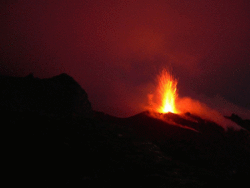Earth:Strombolian eruption
In volcanology, a Strombolian eruption is a type of volcanic eruption with relatively mild blasts, typically having a Volcanic Explosivity Index of 1 or 2.[1] Strombolian eruptions consist of ejection of incandescent cinders, lapilli, and volcanic bombs, to altitudes of tens to a few hundreds of metres. The eruptions are small to medium in volume, with sporadic violence. This type of eruption is named for the Italian volcano Stromboli.
The tephra typically glows red when leaving the vent, but its surface cools and assumes a dark to black colour and may significantly solidify before impact. The tephra accumulates in the vicinity of the vent, forming a cinder cone. Cinder is the most common product; the amount of volcanic ash is typically rather minor.
The lava flows are more viscous, and therefore shorter and thicker, than the corresponding Hawaiian eruptions; it may or may not be accompanied by production of pyroclastic rock.
Instead the gas coalesces into bubbles, called gas slugs, that grow large enough to rise through the magma column, bursting near the top due to the decrease in pressure and throwing magma into the air. Each episode thus releases volcanic gases, sometimes as frequently as a few minutes apart. Gas slugs can form as deep as 3 kilometers, making them difficult to predict.[2][3]
Strombolian eruptive activity can be very long-lasting because the conduit system is not strongly affected by the eruptive activity, so that the eruptive system can repeatedly reset itself.
Monogenetic cones usually erupt in the Strombolian style. For example, the Parícutin volcano erupted continuously between 1943–1952, Mount Erebus, Antarctica has produced Strombolian eruptions for at least many decades, and Stromboli itself has been producing Strombolian eruptions for over two thousand years. The Romans referred to Stromboli as the "Lighthouse of the Mediterranean".
Violent Strombolian
The most energetic Strombolian eruptions are sometimes termed "Violent Strombolian" by volcanologists.[2] Such eruptions are associated with higher magma gas content, leading to a turbulent churn flow regime in the conduit, producing stronger and much more frequent explosions.[4] File:Paroxysm at Etna, 16-17 November 2013.webm Violent Strombolian eruptions are more explosive in nature than their regular counterparts (up to VEI 3),[5] and may produce sustained lava fountains,[4] long distance lava flows,[6] eruption columns several kilometres in height,[2] and heavy ash fallout.[7] Rarely, Violent Strombolian eruptions may transition into Subplinian eruptions.[8]
Examples of Violent Strombolian activity include the paroxysms of Mt. Etna,[9] the 1943-1952 eruption of Parícutin,[2] the 2021 Cumbre Vieja eruption,[7] and various eruptions of Mt. Vesuvius between 1631 and 1944.[10]
See also
References
- ↑ Newhall, Christopher G.; Self, Stephen (20 February 1982). "The Volcanic Explosivity Index (VEI): An Estimate of Explosive Magnitude for Historical Volcanism". Journal of Geophysical Research 87 (C2): 1232. doi:10.1029/JC087iC02p01231. Bibcode: 1982JGR....87.1231N.
- ↑ 2.0 2.1 2.2 2.3 Burton, Mike; Allard, Patrick; Muré, Filippo; Spina, Alessandro La (13 July 2007). "Magmatic Gas Composition Reveals the Source Depth of Slug-Driven Strombolian Explosive Activity". Science 317 (5835): 227–230. doi:10.1126/science.1141900. PMID 17626881. Bibcode: 2007Sci...317..227B.
- ↑ Clarke, Hamish (13 July 2007). "Volcanoes belch 'slugs' from deep underground". Cosmos online. http://www.cosmosmagazine.com/node/1456.
- ↑ 4.0 4.1 Ulivieri, Giacomo; Ripepe, Maurizio; Marchetti, Emanuele (2013-06-28). "Infrasound reveals transition to oscillatory discharge regime during lava fountaining: Implication for early warning" (in en). Geophysical Research Letters 40 (12): 3008–3013. doi:10.1002/grl.50592. ISSN 0094-8276. Bibcode: 2013GeoRL..40.3008U. https://agupubs.onlinelibrary.wiley.com/doi/10.1002/grl.50592.
- ↑ Macedonio, G.; Costa, A.; Folch, A. (2008-12-20). "Ash fallout scenarios at Vesuvius: Numerical simulations and implications for hazard assessment". Journal of Volcanology and Geothermal Research. Evaluating Explosive Eruption Risk at European Volcanoes 178 (3): 366–377. doi:10.1016/j.jvolgeores.2008.08.014. ISSN 0377-0273. Bibcode: 2008JVGR..178..366M. https://www.sciencedirect.com/science/article/pii/S0377027308004599.
- ↑ Carracedo, Juan C.; Troll, Valentin R.; Day, James M. D.; Geiger, Harri; Aulinas, Meritxell; Soler, Vicente; Deegan, Frances M.; Perez-Torrado, Francisco J. et al. (2022). "The 2021 eruption of the Cumbre Vieja volcanic ridge on La Palma, Canary Islands" (in en). Geology Today 38 (3): 94–107. doi:10.1111/gto.12388. ISSN 0266-6979. Bibcode: 2022GeolT..38...94C. https://onlinelibrary.wiley.com/doi/10.1111/gto.12388.
- ↑ 7.0 7.1 Presa, Leticia; Rosado, Santiago; Peña, Christian; Martín, Domingo Alfonso; Costafreda, Jorge Luis; Astudillo, Beatriz; Parra, José Luis (2023). "Volcanic Ash from the Island of La Palma, Spain: An Experimental Study to Establish Their Properties as Pozzolans" (in en). Processes 11 (3): 657. doi:10.3390/pr11030657. ISSN 2227-9717.
- ↑ Cioni, Raffaello; Pistolesi, Marco; Rosi, Mauro (2015-01-01), Sigurdsson, Haraldur, ed., Chapter 29 - Plinian and Subplinian Eruptions, Amsterdam: Academic Press, pp. 519–535, doi:10.1016/b978-0-12-385938-9.00029-8, ISBN 978-0-12-385938-9, https://www.sciencedirect.com/science/article/pii/B9780123859389000298, retrieved 2024-01-08
- ↑ Pioli, Laura; Palmas, Marco; Behncke, Boris; De Beni, Emanuela; Cantarero, Massimo; Scollo, Simona (2022). "Quantifying Strombolian Activity at Etna Volcano" (in en). Geosciences 12 (4): 163. doi:10.3390/geosciences12040163. ISSN 2076-3263. Bibcode: 2022Geosc..12..163P.
- ↑ Scandone, Roberto; Giacomelli, Lisetta; Speranza, Francesca Fattori (2008-03-10). "Persistent activity and violent strombolian eruptions at Vesuvius between 1631 and 1944". Journal of Volcanology and Geothermal Research 170 (3): 167–180. doi:10.1016/j.jvolgeores.2007.09.014. ISSN 0377-0273. Bibcode: 2008JVGR..170..167S. https://www.sciencedirect.com/science/article/pii/S0377027307003320.
External links
- explanation with photos on academic site
- comparison of volcanic blast types
- USGS Photo Glossary
- Modelling of Volcano for CG/CFD Papers with abstracts, images, and PDFs of modelling of Strombolian (explosive) volcano for computer graphics (CG) and computational fluid dynamics (CFD). The main entrance page is here.
 |



